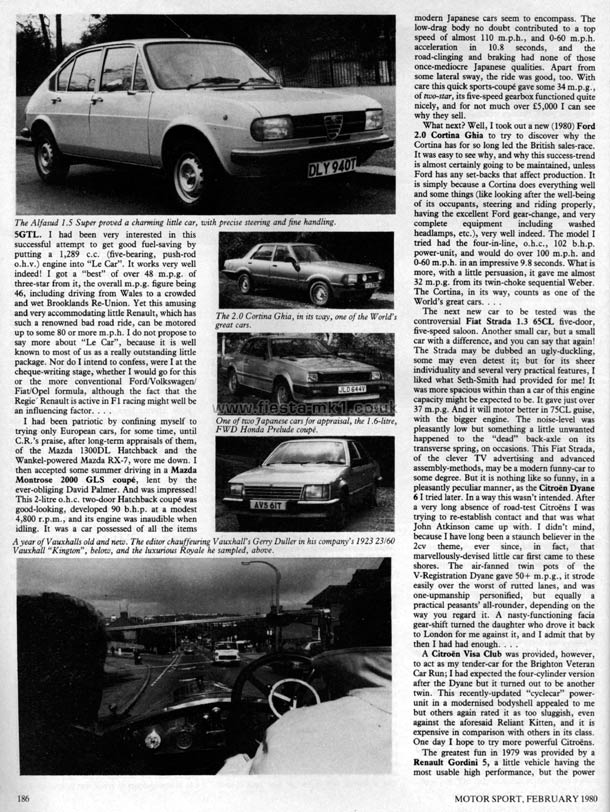Copy of Article Text Below
.....5GTL. I had been very interested in this successful attempt to get good fuel-saving by putting a 1,289 c.c. (five-bearing, push-rod o.h.v.) engine into "Le Car". It works very well indeed! I got a "best" of over 48 m.p.g. of three-star from it, the overall m.p.g. figure being 46, including driving from Wales to a crowded and wet Brooklands Re-Union. Yet this amusing and very accommodating little Renault, which has such a renowned bad road ride, can be motored up to some 80 or more m.p.h. I do not propose to say more about "Le Car", because it is well known to most of us as a really outstanding little package. Nor do I intend to confess, were I at the cheque-writing stage, whether I would go for this or the more conventional Ford/Volkswagen/ Fiat/Opel formula, although the fact that the Regie' Renault is active in Fl racing might well be an influencing factor. . . .
I had been patriotic by confining myself to trying only European cars, for some time, until C.R.'s praise, after long-term appraisals of them, of the Mazda 1300DL Hatchback and the Wankel-powered Mazda RX-7, wore me down. I then accepted some summer driving in a Mazda Montrose 2000 GLS coupe, lent by the ever-obliging David Palmer. And was impressed! This 2-litre o.h.c. two-door Hatchback coupe was good-looking, developed 90 b.h.p. at a modest 4,800 r.p.m., and its engine was inaudible when idling. It was a car possessed of all the items modern Japanese cars seem to encompass. The low-drag body no doubt contributed to a top speed of almost 110 m.p.h., and 0-60 m.p.h. acceleration in 10.8 seconds, and the road-clinging and braking had none of those once-mediocre Japanese qualities. Apart from some lateral sway, the ride was good, too. With care this quick sports-coup6 gave some 34 m.p.g., of two-star, its five-speed gearbox functioned quite nicely, and for not much over £5,000 I can see why they sell.
What next? Well, I took out a new (1980) Ford 2.0 Cortina Ghia to try to discover why the Cortina has for so long led the British sales-race. It was easy to see why, and why this success-trend is almost certainly going to be maintained, unless Ford has any set-backs that affect production. It is simply because a Cortina does everything well and some things (like looking after the well-being of its occupants, steering and riding properly, having the excellent Ford gear-change, and very complete equipment including washed headlamps, etc.), very well indeed. The model I tried had the four-in-line, o.h.c., 102 b.h.p. power-unit, and would do over 100 m.p.h. and 0-60 m.p.h. in an impressive 9.8 seconds. What is more, with a little persuasion, it gave me almost 32 m.p.g. from its twin-choke sequential Weber. The Cortina, in its way, counts as one of the World's great cars. . . .
The next new car to be tested was the controversial Fiat Strada 1.3 6SCL five-door, five-speed saloon. Another small car, but a small car with a difference, and you can say that again! The Strada may be dubbed an ugly-duckling, some may even detest it; but for its sheer individuality and several very practical features, I liked what Seth-Smith had provided for me! It was more spacious within than a car of this engine capacity might be expected to be. It gave just over 37 m.p.g. And it will motor better in 75CL guise, with the bigger engine. The noise-level was pleasantly low but something a little unwanted happened to the "dead" back-axle on its transverse spring, on occasions. This Fiat Strada, of the clever TV advertising and advanced assembly-methods, may be a modern funny-car to some degree. But it is nothing like so funny, in a pleasantly peculiar manner, as the Citroen Dyane 61 tried later. In a way this wasn't intended. After a very long absence of road-test Citroens I was trying to re-establish contact and that was what John Atkinson came up with. I didn't mind, because I have long been a staunch believer in the 2cv theme, ever since, in fact, that marvellously-devised little car first came to these shores. The air-fanned twin pots of the V-Registration Dyane gave 50+ m.p.g., it strode easily over the worst of rutted lanes, and was one-upmanship personified, but equally a practical peasants' all-rounder, depending on the way you regard it. A nasty-functioning facia gear-shift turned the daughter who drove it back to London for me against it, and I admit that by then I had had enough. . . .
A Citroen Visa Club was provided, however, to act as my tender-car for the Brighton Veteran Car Run; I had expected the four-cylinder version after the Dyane but it turned out to be another twin. This recently-updated "cyclecar" power-unit in a modernised bodyshell appealed to me but others again rated it as too sluggish, even against the aforesaid Reliant Kitten, and it is expensive in comparison with others in its class. One day I hope to try more powerful Citroens.
The greatest fun in 1979 was provided by a Renault Gordini 5, a little vehicle having the most usable high performance, but the power.....
Captions -
Top-Left - The Alfasud 1.5 Super proved a charming little car, with precise steering and fine handling.
Top-Middle - The 2.0 Cortina Ghia, in its way, one of the World's great cars.
Middle - One of two Japanese cars for appraisal, the 1.6-litre, FWD Honda Prelude coupe.
Bottom-Left - A year of Vauxhalls old and new. The editor chauffeunng Vauxhall's Gerry Duller in his company's 1923 23/60 Vauxhall "Kington", below, and the luxurious Royale he sampled, above.
|






